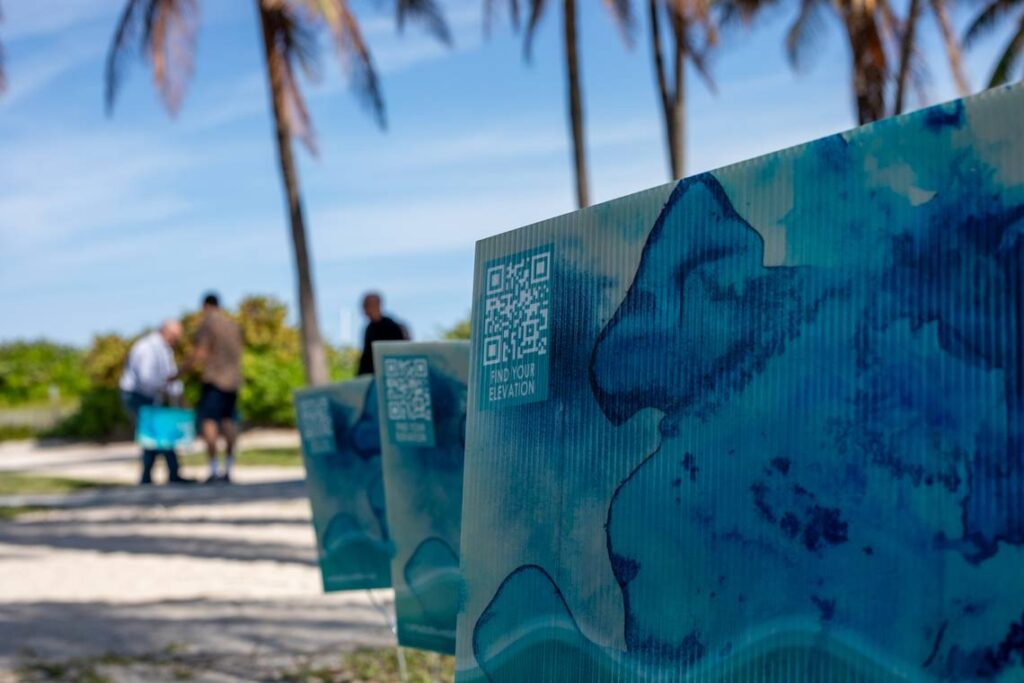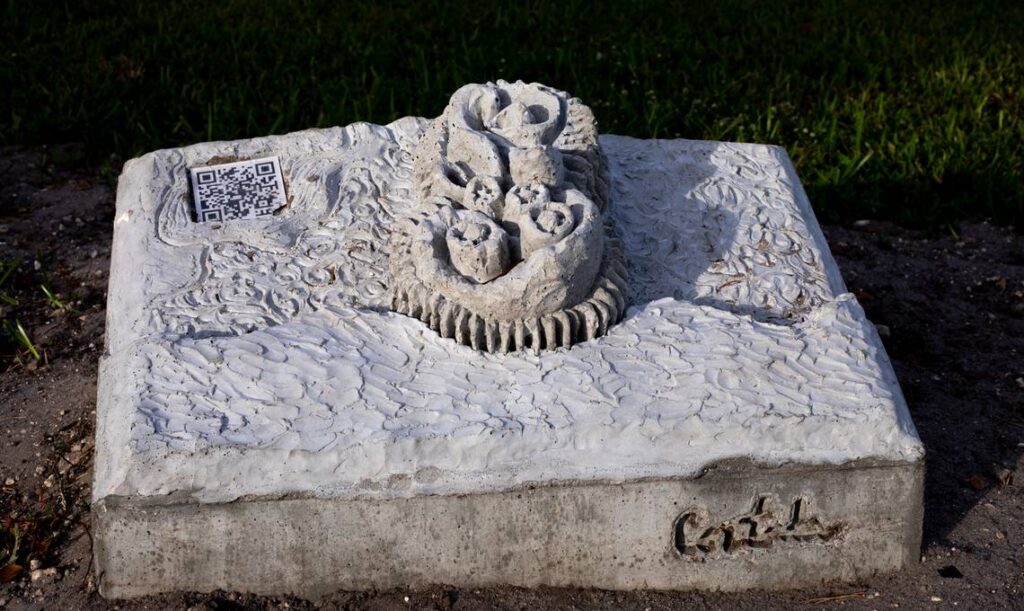By Ashley Miznazi
12/7/23

Miami artist Xavier Cortada’s project, The Underwater, aims to send a message about climate change to Art Basel visitors and residents.
For more than three decades, the environment has been a muse for Miami artist, Xavier Cortada. His latest installation for Miami Art Week won’t be found in a gallery or exhibit space. Instead, you might spot it while strolling downtown, in Wynwood, on Lincoln Road, on the sands of Miami Beach or maybe visiting a business. As part of an on-going project he calls The Underwater, Cortada has distributed 5,500 signs, each swimming in the blues and greens of the waters off the South Florida coast and bearing a QR code. They’re intended to deliver a message about the looming threat of sea rise. If Art Basel visitors, or anyone else, scans the code it takes them to a website that shows projected rise over 100 years and other climate change information. He hopes it will be eye-opening. “I wanted to create a community-wide participatory art installation to understand we are all in this together, and instead of kicking the can down the road to the future we can work to adapt now to the future of rising seas,” Cortada said.

A biker passes by the yard signs Xavier Cortada installed in a progression at Sandy’s Beach in Miami Beach on Monday, Dec. 6. Ashley Miznazi amiznazi@miamiherald.com
“Especially this week when people fly on their private jets, and art is about commodity, I wanted to launch this art project so we can see what really matters.”
On Tuesday, the Cortada Foundation — which he started with the goal of using art to engage people in climate change and social just issues — put a sea of signs at the entrance of Sandy Beach in South Beach, near the Art Basel tents, and set up a table to hand out free signs residents can place in their own yards. The colorful signs — each with a large 6 on it that represents the number of feet the sea level is expected to rise by the end of the century in Miami Dade — were funded by the Knight Foundation, which supports arts projects across South Florida. They attracted lots of curious looks but most tourists walked by without stopping to scan the QR codes. A pair of friends from Germany did, and then took a sign back to their Airbnb. The sign design, Cortada said, was inspired by a visit to Antarctica in 2006 during an art fellowship. A scientist handed Cortada a piece of ice from the melting glaciers they were studying and explained the melting would eventually sink parts of Miami. Cortada, who has only ever called Miami home, was shaken by the conversation.

QR codes on the yard signs lead to a website to find the elevation above sea level of an address. Ashley Miznazi amiznazi@miamiherald.com
He put away the colorful, tropical Cuban-styled art colors he came to the fellowship expected to use, and pulled out only the blue paint. He placed the ice onto the paper and added paint by brushing and squirting it from the bottle. As the ice melted, the pigment and water spread on the paper, leaving behind the imprint of melted ice. “Those pieces of paper were the precursor to what was to come,” he said. Read More: King tide floods offer glimpse of Miami’s soggy, salty future The Art Week installations are his latest expansion of The Underwater project. He is also working to place permanent climate warning markers around the county, including in parks. So far, six out of the 287 Miami-Dade county parks have installed 400-pound concrete markers designed by Cortada and built by Francisco De Caso, a principal scientist at the University of Miami at the College of Engineering and his lab.
In keeping with the environmental theme, De Caso changed the typical mix of metal reinforcing bars, concrete and fresh water. Instead of steel or iron, De Caso used fiber-enforced polymer bars which he said “opens a world of possibilities” in future construction. Homes, for instance, could be built with saltwater from Key Biscayne in the mix instead of valuable freshwater.
“Even if sea rise makes them go underwater, the marker won’t corrode,” De Caso said.
The team is also using “recycled contaminated aggregates” or concrete from demolished building that breaks down into pieces and usually winds up in the landfill.
The first set of markers were a collaboration of university and industry with UM. For the next set, De Caso hopes the county Parks and Recreation Department will kick in financial support.
In 2022, the Cortada Foundation received a $50,000 grant from the non-profit Creative Capital, for The Underwater. Christine Kuan, the president and executive director of Creative Capital, said they liked how the project opened up the climate conversation without judgment or requirement of advanced degrees.
“It’s simple, emotional and beautiful,” she said.
But Cortada also collaborates with scientists, including Brian Haus at the University of Miami, who has been working with the artist since 2018 on the first iteration of the project launched in Pinecrest called The Underwater HOA.
“In the 30 years since I’ve been at UM you can physically see the sea level difference. It’s unprecedented what we have seen,” Brian Haus, a professor and department chair of ocean sciences, said on a panel Monday for The Underwater Miami Art Week launch.
The project has gotten some pushback over the years, mainly from the real estate industry, Cortada and Haus said.
“They said we can’t get the information out there because real estate value would drop,” Haus said.

Permanent concrete structure shows that Oak Grove Park, located in the Golden Glades, sits eight feet above sea level. Ashley Miznazi amiznazi@miamiherald.com

Link to original article: https://www.miamiherald.com/news/local/environment/climate-change/article282771438.html